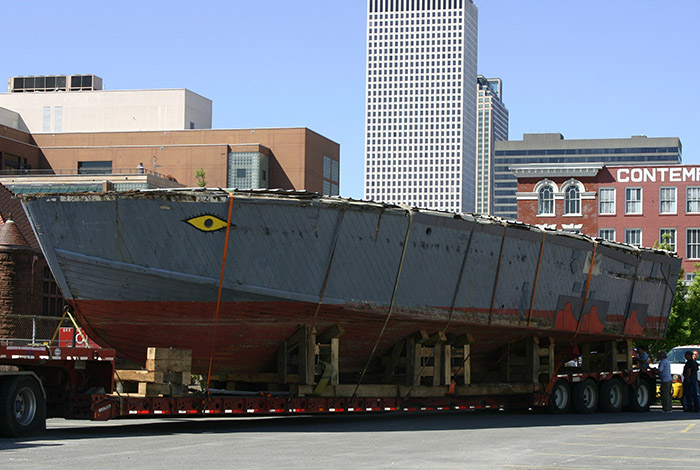A fully restored 1940s U.S. Navy patrol torpedo boat is getting close to launching in New Orleans, as the National World War II Museum makes a final online fundraising push to complete the $3.3 million project.
PT-305 came out of the Higgins Industries yards in the Crescent City, served in the Mediterranean before postwar decommissioning, and enjoyed a long civilian career as a tour boat and fishing vessel passed among 11 owners.
The 78’x20’8”x5’3” vessel has been undergoing 100,000 hours of restoration work by 200 volunteers, in the museum’s glass-walled Kushner Restoration Pavilion. The next steps will be moving the PT-305 to the Race Street Wharf, loading it on a barge and towing it to a facility on the Industrial Canal for sea trials and two to three months of testing to certify the vessel for passenger service.
Once that is finished, the museum plans to operate PT-305 from a custom boat house on Lake Pontchartrain, where it was first tested by Higgins in 1943, carrying passengers to experience what it was like on the high-speed attack boats, among the first Navy units thrown into combat during the Second World War.
“The restoration of PT-305, like all Museum restoration projects, is aimed at making history accessible to today’s audiences in as detailed and authentic a way possible,” said Stephen Watson, the museum’s executive vice president and chief operating officer. It is a prize goal in the museum’s mission of “making history accessible to today’s audiences in as detailed and authentic a way possible,” he said.
Higgins and the Electric Launch Company, by then known under the acronym ELCO, Bayonne, N.J., built most of the Navy’s torpedo boats. For a generation they symbolized American courage and daring, after PT boats gained fame during 1942 battles in the Pacific islands, punching far above their weight in night fighting against the Japanese navy.
Laid down at the end of March 1943, PT-305 was launched just under two months later, then commissioned that December and assigned to Motor Torpedo Squadron 22. Based at Bastia on the island of Corsica, and later at St. Tropez in France, the PT crews hunted German shipping as the Allies pressed their way into southern Europe.
Powered by a trio of Packard W-14 M2500 gasoline engines, each burning 100-octane aviation gasoline to turn 1,500 hp on three shafts, the Higgins PT boats could sustain 27 knots and hit 41 knots at top end. A crew up to 17 sailors manned four Mk 13 torpedoes launched from on deck, a single 40 mm and two 20 mm deck cannons, two twin and two single .50 caliber machine guns, and a 60 mm mortar.

Ensign Bleeker Morse (left) and Lieutenant Junior Grade Allan Purdy on the bridge of PT-305 in Leghorn (Livorno), Italy, on March 16, 1945. The “kill plaques” on the chart house signify the two enemy craft sunk by PT-305 to that date. Photo: Gift of Joseph Brannan used courtesy of The National WWII Museum.
The squadron participated in Allied landings on Elba on June 18, 1944, where PT-305 sank a flak lighter – one of a class of 163’ armored self-propelled barges the Germans used to move in coastal waters, armed with 88 mm cannon that could blow a PT boat out of the water. In August the boats were part of the force invading southern France, landing French commandos in the early hours of the operation.
The PT boats kept up pressure on Axis forces, harassing shipping in Genoa and other harbors, and facing off against their enemy torpedo-boat counterparts. On the night of April 24, 1945, PT-305 claimed one, sinking an Italian MAS boat.
At the end of the war in Europe, PT-305 and others in the squadron were shipped back to the United States for reconditioning and transfer to the Pacific theatre of operations. The boats were tied up in New York City when Japan surrendered, and the squadron went out of service in November 1945.
PT-305’s crewmen had assigned it a series of ironic nicknames, including Higgins Mortuary in honor of the builders, and Sudden Jerk, memorializing a botched docking maneuver. As war surplus, the boat entered into a long series of second acts when the War Shipping Administration in 1948 sold it, and PT-305 wound up with commercial fisherman Frank Reis of Provincetown, Mass.
Through the 1950s the vessel passed through owners south down the coast. It lingered through the 1960s with party fishing boat operators at Manasquan Inlet, N.J., first as the Jersey, then Dauntless and Man O’ War, before heading down to the Carolinas and Florida.

The PT-305 in 1954 as the fishing party boat Jersey. Photo courtesy Capt. David Bogan Sr./Bogan family.
Many owners later, the vessel ended its career as a battered Chesapeake Bay oyster boat – shortened by 13’ sawn off its stern to escape Coast Guard regulations on vessels over 65’ at the time. Finally, it was obtained in March 2001 by the Defenders of America Naval Museum, Inc., Kemah, Texas, a volunteer group that hoped to restore it. But faced with daunting costs and tens of thousands of hours in restoration, the group ultimately reached out to the National WWII Museum.
In Match the museum launched an online Kickstarter fundraising drive to start toward a final $500,000 to get PT-305 into the water and tested for operations. The campaign hit its $100,000 goal in just three days.
When PT-305 rides again, it will be among just two of four surviving veteran World War II American torpedo boats restored to restored to near-original operational conditions, including the Packard engines – gas guzzlers that civilian operators tended to replace with diesels as the postwar fleet was dispersed to peaceful uses. Another Higgins survivor, PT-658, continues to be restored and operated on the water by the non-profit Save the PT Boat, Inc., of Portland, Ore.





